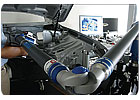
CAD and virtual prototypes have long been part and parcel of the engineer’s toolkit at automakers like Volkswagen, Daimler and Toyota. As a result, the time and cash investments in prototype construction have fallen considerably.
However, automakers still need to test for proper integration of new components, such as a new motor for an existing vehicle model.
Augmented reality is a technology that helps ensure proper integration by combining virtual prototypes with real components. Metaio of Munich, Germany, is a pioneer in this technology and develops software products for systems driven by visual interaction in both real and virtual worlds. The company’s Unifeye software platform not only lets users place 3D animations directly into live video streams, but also supports the seamless integration of images from the external user environment.
In cooperation with measurement arm specialist Faro, Metaio recently developed Unifeye Prototyping, a system that lets engineers measure virtual CAD prototypes with real elements. With Unifeye Prototyping, engineers can more quickly indentify problems, such as whether future components can be installed in an existing vehicle.
Unifeye Prototyping has been used by automakers Volkswagen, Audi and Ford. “Augmented reality delivers the perfect interface for us between theory and practice,” says Ute Gehle of Ford Werke GmbH in Germany. “With this tool, our CAD development work meets up with the reality of actual vehicles and prototypes and their tolerances. Thanks to early recognition of assembly issues, we save a lot of time and money and avoid difficulties that have negative effects on quality.”
The system consists of a Faro measuring arm, to which a digital Guppy F-080C color camera from Allied Vision Technologies Inc. is attached. The camera connects to the system computer via a digital FireWire interface, and it delivers a live video stream of the object. The camera features XGA resolution (0.8 megapixel) at an image rate of 30 frames per second.
The arm’s three-dimensional positioning helps the engineer precisely locate the physical prototype. Specialized software processes the video data as the virtual 3D element is integrated into the real image.
The camera does two things with the virtual 3D images: It allows them to be adapted in real time to the changing angle of view, and it precisely overlays them onto the live stream. On a nearby monitor, the engineer sees the combined image of a virtual prototype built into the real one. These images help prevent errors during preproduction that previously could only be found on the first physical prototype of the new component.
For example, a combined image can let a draftsman see in real time if a virtual screw is missing or if the geometry of both parts is less than optimally aligned in any way.
“It’s all about detail,” says Dr. Ronald Müller, product manager industrial AR solutions of Metaio. “The AVT Guppy won us over with its high image quality and compact dimensions that don’t limit arm movement.”
For more information on digital FireWire cameras, call 877-872-1394 or visit www.alliedvisiontec.com.



